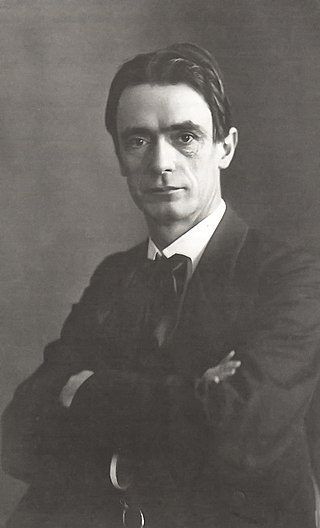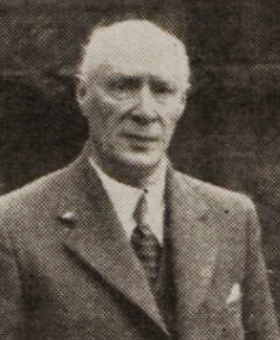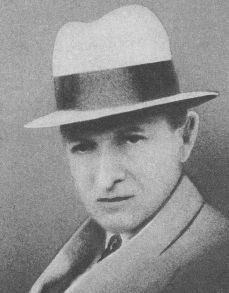Related Research Articles

In the religion of Theosophy and the spiritual movement called Anthroposophy, the Akashic records are a compendium of all universal events, thoughts, words, emotions and intent ever to have occurred in the past, present, or future in terms of all entities and life forms, not just human. They are believed by theosophists to be encoded in a non-physical plane of existence known as the mental plane. Because it is believed that the records are encoded vibrationally into the inherent fabric of space, some have likened the mechanism as similar to how holograms are created. There is currently no scientific evidence for the existence of the Akashic records, and rigorous scientific research in this field has seen little traction.

Alice Ann Bailey was a writer of more than twenty-four books on theosophical subjects, and was one of the first writers to use the term New Age. Bailey was born as Alice La Trobe-Bateman, in Manchester, England. She moved to the United States in 1907, where she spent most of her life as a writer and teacher.
Lemuria, or Limuria, was a continent proposed in 1864 by zoologist Philip Sclater, theorized to have sunk beneath the Indian Ocean, later appropriated by occultists in supposed accounts of human origins. The theory was discredited with the discovery of plate tectonics and continental drift in the 20th century.

James Lewis Thomas Chalmers Spence was a Scottish journalist, poet, author, folklorist and occult scholar. Spence was a Fellow of the Royal Anthropological Institute of Great Britain and Ireland, and vice-president of the Scottish Anthropological and Folklore Society. He founded the Scottish National Movement.

Vril: The Power of the Coming Race, originally published as The Coming Race, is a novel by Edward Bulwer-Lytton, published anonymously in 1871.

The Secret Doctrine, the Synthesis of Science, Religion and Philosophy, is a pseudoscientific esoteric book originally published as two volumes in 1888 written by Helena Blavatsky. The first volume is named Cosmogenesis, the second Anthropogenesis. It was an influential example of the revival of interest in esoteric and occult ideas in the modern age, in particular because of its claim to reconcile ancient eastern wisdom with modern science. Proponents widely claim the literature contains clues as to how the nature of prayer was 'covered' and expunged from common wisdom, except for those with a keen-eye.

Alfred Percy Sinnett was an English author and theosophist.

Root races are stages in human evolution in the esoteric cosmology of theosophist Helena Petrovna Blavatsky, as described in her book The Secret Doctrine (1888). These races existed mainly on now-lost continents. Blavatsky's model was developed by later theosophists, most notably William Scott-Elliot in The Story of Atlantis (1896) and The Lost Lemuria (1904). Annie Besant further developed the model in Man: Whence, How and Whither (1913). Both Besant and Scott-Elliot relied on information from Charles Webster Leadbeater obtained by "astral clairvoyance". Further elaboration was provided by Rudolf Steiner in Atlantis and Lemuria (1904). Rudolf Steiner, and subsequent theosophist authors, have called the time periods associated with these races Epochs.
Agartha is a legendary kingdom that is said to be located on the inner surface of the Earth. It is sometimes related to the belief in a hollow Earth and is a popular subject in esotericism.

The Book of Dzyan is a reputedly ancient text of Tibetan origin. The Stanzas formed the basis for The Secret Doctrine (1888), one of the foundational works of the theosophical movement, by Helena Petrovna Blavatsky. The book has influenced writers in the ancient astronaut, occult and UFO communities. Historians and skeptics have dismissed the Book of Dzyan as a hoax and have accused Blavatsky of plagiarism.

Morya, also spelt Maurya, is one of the "Masters of the Ancient Wisdom" within modern Theosophical beliefs. He is believed by followers of Theosophism to be one of the Mahatmas who inspired the founding of the Theosophical Society and was engaged in a correspondence with two English Theosophists living in India, A. P. Sinnett and A. O. Hume. The correspondence was published in 1923 by A. Trevor Barker, in the book The Mahatma Letters to A. P. Sinnett.

Harold Tom Wilkins was a British journalist known for his books on treasure hunting and pseudohistoric claims about Atlantis and South America.

In Theosophy, Maitreya or Lord Maitreya is an advanced spiritual entity and high-ranking member of a reputed hidden spiritual hierarchy, the Masters of the Ancient Wisdom. According to Theosophical doctrine, one of the hierarchy's functions is to oversee the evolution of humankind; in concert with this function Maitreya is said to hold the "Office of the World Teacher". Theosophical texts posit that the purpose of this Office is to facilitate the transfer of knowledge about the true constitution and workings of Existence to humankind. Humanity is thereby assisted on its presumed cyclical, but ever progressive, evolutionary path. Reputedly, one way the knowledge transfer is accomplished is by Maitreya occasionally manifesting or incarnating in the physical realm; the manifested entity then assumes the role of World Teacher of Humankind.
In the teachings of Theosophy, the Manu is one of the most important beings at the highest levels of Initiation of the Masters of the Ancient Wisdom, along with Sanat Kumara, Gautama Buddha, Maitreya, the Maha Chohan, and Djwal Khul. According to Theosophy, each root race has its own Manu which physically incarnates in an advanced body of an individual of the old root race and physically progenerates with a suitable female partner the first individuals of the new root race. The Theosophical concept of the Manu is derived from the concept in Hinduism that the Manu was the being who was the progenitor of the human race.

Man: Whence, How and Whither, A Record of Clairvoyant Investigation, published in 1913, is a theosophical book compiled by the second president of the Theosophical Society (TS) - Adyar, Annie Besant, and by a TS member, Charles W. Leadbeater. The book is a study on early times on planetary chains, beginnings of early root races, early civilizations and empires, and past lives of men.

Within the system of Theosophy, developed by occultist Helena Blavatsky and others since the second half of the 19th century, Theosophical mysticism draws upon various existing disciplines and mystical models, including Neo-platonism, Gnosticism, Western esotericism, Freemasonry, Hinduism and Buddhism.

Theosophy is a religion established in the United States during the late 19th century. It was founded primarily by the Russian Helena Blavatsky and draws its teachings predominantly from Blavatsky's writings. Categorized by scholars of religion as both a new religious movement and as part of the occultist stream of Western esotericism, it draws upon both older European philosophies such as Neoplatonism and Indian originated religions such as Hinduism and Buddhism.

Modern Theosophy is classified by prominent representatives of Western philosophy as a "pantheistic philosophical-religious system." Russian philosopher Vladimir Trefilov claimed that Blavatsky's doctrine was formed from the beginning as a synthesis of philosophical views and religious forms of the various ages and peoples with modern scientific ideas. Michael Wakoff, an author of The Routledge Encyclopedia of Philosophy, stated that Blavatskian Theosophy was based on Buddhist and Hindu philosophy, and fragments of the Western esotericism with using an "absolutist metaphysics." In The New Encyclopedia of Philosophy it is said that Blavatsky's Theosophy is an attempt to merge into a universal doctrine all religions by revealing their "common deep essence" and detection of "identity meanings of symbols," all philosophies, and all sciences.

Hinduism is regarded by modern Theosophy as one of the main sources of "esoteric wisdom" of the East. The Theosophical Society was created in a hope that Asian philosophical-religious ideas "could be integrated into a grand religious synthesis." Prof. Antoine Faivre wrote that "by its content and its inspiration" the Theosophical Society is greatly dependent on Eastern traditions, "especially Hindu; in this, it well reflects the cultural climate in which it was born." A Russian Indologist Alexander Senkevich noted that the concept of Helena Blavatsky's Theosophy was based on Hinduism. According to Encyclopedia of Hinduism, "Theosophy is basically a Western esoteric teaching, but it resonated with Hinduism at a variety of points."
According to some literary and religious studies scholars, modern Theosophy had a certain influence on contemporary literature, particularly in forms of genre fiction such as fantasy and science fiction. Researchers claim that Theosophy has significantly influenced the Irish literary renaissance of the late 19th and early 20th centuries, notably in such figures as W. B. Yeats and G. W. Russell.
References
- ↑ Martin Gardner, Fads and Fallacies in the Name of Science, 1957, p. 168
- ↑ Nicholas Goodrick-Clarke, Occult Roots of Nazism: Secret Aryan Cults and Their Influence on Nazi Ideology, 1993, p. 53
- ↑ Gary Lachman, Politics and the Occult: The Left, the Right, and the Radically Unseen, 2008, p. 190
- ↑ Lewis Spence, 1976, The Occult Sciences in Atlantis, p. 24
- ↑ Karl Shaw, Curing Hiccups with Small Fires: A Delightful Miscellany of Great British Eccentrics
- ↑ Christopher Chippindale, Stonehenge complete, Cornell University Press, 1983, p. 246